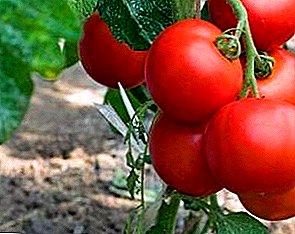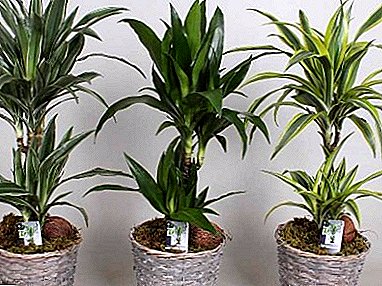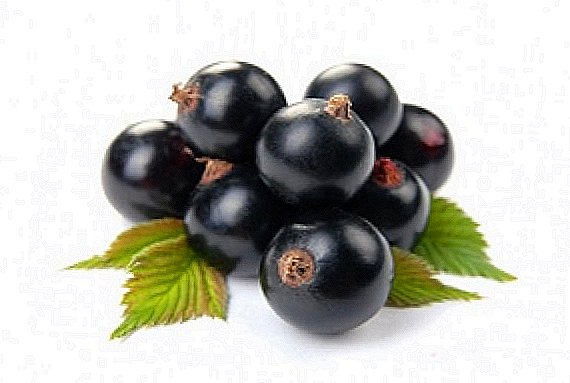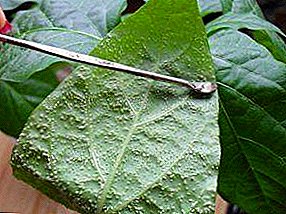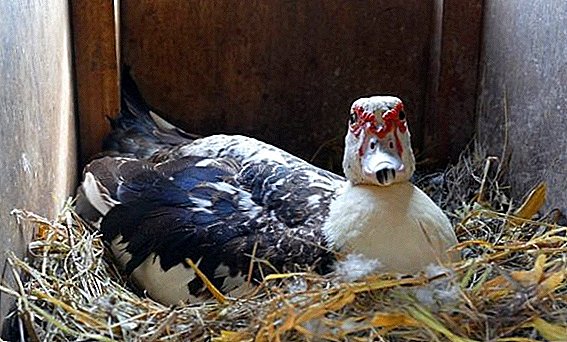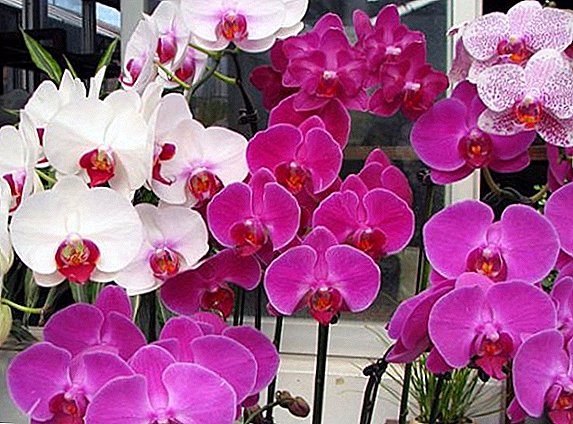 Phalaenopsis is from South Asia and belongs to the Orchid family. The flower has a striking long flowering and a variety of colors of beautiful, unusual shape of flowers, for which he deservedly gained popularity among flower growers.
Phalaenopsis is from South Asia and belongs to the Orchid family. The flower has a striking long flowering and a variety of colors of beautiful, unusual shape of flowers, for which he deservedly gained popularity among flower growers.
Phalaenopsis orchid: features of growing plants
A favorable condition for flowers is a humid climate, since in their homeland they grew at the foot of the mountains and on flatlands. The average phalaenopsis is a small flower on a long stem, with dark green leaves and an extensive root system.
Did you know? Some individuals of the Orchid family can even live on other plants: on the bark of trees.Another feature of phalaenopsis orchids is the reproduction method. They have seed capsules with pollen that is carried by the wind. Also, flowers have a pleasant aroma that attracts insects.

Optimum conditions for keeping and planting a flower
Phalaenopsis orchid is not very whimsical in care. But An important aspect is choosing the right place for the pot. It is necessary to arrange the plant so that the direct rays of the sun do not fall on the leaves, because they can leave burns. Also, every couple of weeks you need to turn the pot so that the plant does not lean in one direction.
Important! But during the flowering of phalaenopsis at home it is better not to disturb the plant.
Humidity and temperature
Optimum humidity of air - 30-40%. Also the room should be well ventilated. With an excess of moisture the leaves can rot. No need to spray the plants, because moisture can fall into the buds and sinuses of leaves. It can also lead to decay. And with a lack of moisture, you can use a wet pebble pan, thereby adjusting the moisture level of the plant.
Important! Phalaenopsis terribly dislikes drafts and sharp winds. Air conditioning is also better not to include indoors with orchids.Phalaenopsis has a comfortable temperature of 15-25 ° C. The plant, of course, is able to withstand both higher temperatures and lower ones. But it is better not to experiment, but to take into account all the preferences of the orchid.
Orchid lighting
Very delicate leaves of a flower are extremely demanding in lighting and do not tolerate direct hits from the best sun. Phalaenopsis orchid loves soft and natural light, therefore it is best to place the pot near the eastern windows. During flowering, you can use additional light sources to form a bud without pain. 
Did you know? A healthy, dark green leaf shade will tell you about the adequacy of coverage.It is worth noting that phalaenopsis roots are involved in the process of photosynthesis, therefore, they need natural soft light.
Requirements for soil for planting
Any newcomer knows that orchid roots need air. Therefore, the soil for phalaenopsis should be large and water-holding. Bark of trees, peat and charcoal will do for this. Before planting, the soil must be dried, so that it will not moldy from watering.
How to plant a plant
In nature, orchids belong to the group of epiphytes, that is, such plants that grow on the bark of trees. Therefore, any addition of normal soil can lead to the death of orchids. Before planting, you must carefully select the soil. It should be dry, bulky and allow the root system to breathe. Having decided on the substrate, you need to choose a pot. Phalaenopsis will feel very comfortable in a bamboo basket. Also suitable plastic transparent container in which you can easily make holes. 
Did you know? At the bottom of the need to lay drainage in the form of large pieces of bark.Covering the drainage with a small layer of phalaenopsis soil, it is possible to complete the roots. Be careful, because they are very fragile.
Phalaenopsis orchid: how to care at home
Caring for an orchid is the proper watering of the flower, monitoring the sufficiency of light, timely feeding and pruning of the individual. You also need to ensure that the root system of phalaenopsis was comfortable, otherwise the flower should be transplanted into a larger container.
Care for phalaenopsis during flowering also consists in following these rules.
How to water Phalaenopsis
You need to water the orchid only after the substrate has completely dried, but it should be dry for a short time.
Did you know? A signal that it is time to water the flower, are droplets of moisture on the inner walls of the pot or the dull color of the roots.It is recommended to use lower watering phalaenopsis, so that moisture does not fall on the leaves and does not accumulate at their base. Water for irrigation should be soft and filtered.
Important! Once a month you can perform shower procedures. But after you need to wipe the leaves dry.
Phalaenopsis fertilizer
Feeding orchids carried out when watering. Water can be diluted with special fertilizers, which are sold in specialized stores in a wide range. Such irrigation should be carried out twice a month. You can fertilize more often, but then the concentration of feeding in water should be reduced. Feeding is poured only into moist soil.
And once a month, you can spray magnesium sulfate at the rate of 2 g per 1 liter of water.
Pruning orchids
Pruning phalaenopsis is done after flowering plants. If the old arrow turned yellow after a while, then it can be easily cut off. And if not, then phalaenopsis may re-bloom at home. But in any case, the arrow should be slightly shortened.
Important! How many buds on the arrow you leave, so many will be new flowers. But do not leave more than three, because you have to wait a long time for flowering.
When and how to transplant phalaenopsis
It is necessary to transplant a flower every 2-3 years, because the ground is already caked, and the roots feel constrained. If the pot is small and the roots sprout through the drainage holes, then this is also the first bell for transplanting. It is possible to disturb a plant only after it has faded. Replace need to carefully, so as not to disturb the rhizomes. The substrate must be prepared in advance. The simplest version of what can be processed orchid roots during transplantation is charcoal. 
How to care for phalaenopsis orchid after flowering
Owners of orchids wonder what to do with phalaenopsis after flowering. There may be three possible solutions. You can trim the peduncle after it dries. If the arrow has not dried up, then it can be left.
Did you know? After a while, flowers may appear on them, but they will be much smaller and not so bright.The cut peduncle can be put into the water, perhaps it will give "offspring".
How phalaenopsis is propagated
 Phalaenopsis orchid cultivation is a very interesting process. After all, it is possible in several ways.
Phalaenopsis orchid cultivation is a very interesting process. After all, it is possible in several ways.
The first method is the method of rhizome division. To do this, remove the roots from the pot and carefully separate them with a sharp knife. Each cut rhizome must have at least 3 onions. Seating them in separate containers, provide standard care.
Did you know? This method of breeding orchids phalaenopsis is best applied in spring.Young individuals need to start fertilizing every 2-3rd watering.
The second method is seed reproduction. But this method is possible only in laboratory conditions. Indeed, in nature, the seeds develop and feed on the root sponge, and domesticated orchids do not have this nutrient medium. Therefore, this method is very time consuming and costly.  The third way is the breeding of shoots. After some time, sprouts appear near the adult individual, which also need to be cared for. If you like this method of breeding orchids, then pay more attention to these "children": fertilize more often and spray with nitrogen-containing fertilizers.
The third way is the breeding of shoots. After some time, sprouts appear near the adult individual, which also need to be cared for. If you like this method of breeding orchids, then pay more attention to these "children": fertilize more often and spray with nitrogen-containing fertilizers.
Important! Separate the children, be sure to treat the roots of charcoal.
Major pests and diseases of the flower
Any orchid disease phalaenopsis is a consequence of improper care of the plant. Diseases can be either infectious or non-infectious. The most common disease of phalaenopsis is a fungal fusarium of nature. It originates on the rhizomes and can move to the whole plant. This infection is incurable to the plant. And this is just the result of improper watering.
There is a disease of the flowers - urticaria. It originates in low temperatures. It is possible to cure a plant, having neutralized an adverse factor.
Botrytis is a disease that adversely affects flowers. And the reason - poor ventilation and high humidity in the room. You can raise the temperature in the room, thereby slowing the course of the disease.
Also in the shops a lot of pesticides that can stop the disease.


